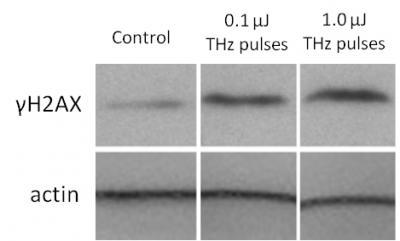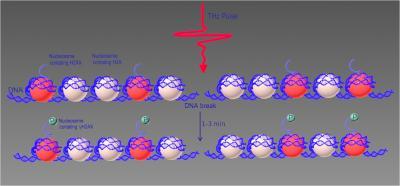Terahertz (THz) radiation, in the electromagnetic spectrum between microwaves and infrared light, is rapidly finding important uses in medical diagnostics, security, and scientific research.
But researchers are pursuing answers regarding potential human health risks.
New studies performed on lab-grown human skin suggests that short but powerful bursts of THz radiation increases the production of proteins that help the body fight cancer - but can also
cause DNA damage
. The findings, which are the result of a collaboration between physicists at the University of Alberta and molecular biologists at the University of Lethbridge in Canada, are published today in the Optical Society's (OSA) open-access journal Biomedical Optics Express.
"While these investigations of the biological effects of intense THz pulses are only just beginning," said Lyubov Titova, with the University of Alberta and a member of the research team, "the fact that intense THz pulses can induce DNA damage but also DNA repair mechanisms in human skin tissue suggests that intense THz pulses need to be evaluated for possible therapeutic applications."
THz photons, like their longer wavelength cousins in the microwave range, are not energetic enough to break the chemical bonds that bind DNA together in the nucleus of cells. These waves, however, have just the right frequency to energize water molecules, causing them to vibrate and produce heat, which is why microwave ovens are so efficient at cooking food. For this reason, it was believed that heat-related injuries were the principal risks posed by THz radiation exposure.
Recent theoretical studies, however, suggest that intense THz pulses of picosecond (one trillionth of a second) duration may directly affect DNA by amplifying natural vibrations (the so-called "breathing" mode) of the hydrogen bonds that bind together the two strands of DNA. As a result, "bubbles" or openings in DNA strands can form. According to the researchers, this raised the question: "Can intense THz pulses destabilize DNA structure enough to cause DNA strand breaks?"
As shown in earlier animal cell culture studies, THz exposure may indeed affect biological function under specific conditions such as high power and extended exposure. There is, however, a vast gulf between animal research and conclusions that can be drawn about human health.

A special gel-based analysis used to detect specific proteins shows elevated levels of gamma H2AX, the marker for DNA damage. It shows that there are elevated levels of the protein in the THz-pulse exposed tissues compared to control samples that weren't exposed. Credit: : Biomedical Optics Express.
In what they call a first-of-its-kind study, the Canadian researchers exposed laboratory-grown human skin tissue to intense pulses of THz electromagnetic radiation and have detected the telltale signs of DNA damage through a chemical marker known as phosphorylated H2AX. At the same time, they observed THz-pulse induced increases in the levels of multiple tumor suppressor and cell-cycle regulatory proteins that facilitate DNA repair. This may suggest that DNA damage in human skin arising from intense picosecond THz pulse exposure could be quickly and efficiently repaired, therefore minimizing the risk of carcinogenesis.
The researchers used a skin tissue model made of normal, human-derived epidermal and dermal cells. This tissue is able to undergo mitosis (cell division) and is metabolically active, thus providing an appropriate platform for assessing the effects of exposure to high intensity THz pulses on human skin. For their study, Titova and her colleagues exposed the skin tissue to picosecond bursts of THz radiation at levels far above what would typically be used in current real-world applications. They then studied the sample for the presence of phosphorylated H2AX, which "flags" the DNA double strand break site and attracts cellular DNA repair machinery to it.
"The increase in the amount of phosphorylated H2AX in tissues exposed to intense THz pulses compared to unexposed controls indicated that DNA double strand breaks were indeed induced by intense THz pulses," observed Titova. Once DNA breaks occur, they can eventually lead to tumors if unrepaired. "This process," she continued, "is very slow and cells have evolved many effective mechanisms to recognize damage, pause cell cycle to allow time for damage to be repaired, and – in case repair is unsuccessful – to prevent damage accumulation by inducing apoptosis, or programmed cell death of the affected cell."

In cell nucleus, DNA is wound around cores made of histone proteins. One of the histone proteins, H2AX, plays important role in recognition of DNA damage. This schematic shows what the researchers suspect is happening to DNA molecules when exposed to strong pulses of THz radiation. The upper row is immediately following the pulse when the strand of DNA is broken. The lower portion shows the H2AX molecules around the break site 1 - 3 minutes later after they are "flagged" by the attachment of a phosphate group, which signals that DNA damage has taken place. Credit: : Ayesheshim K. Ayesheshim.
The researchers confirmed that these cellular repair mechanisms were taking place by detecting an elevated presence of multiple proteins that play vital roles in DNA repair, including protein p53 (often called "a guardian of the genome"); p21, which works to stop cell division to allow time for repair; protein Ku70, which helps reconnect the broken DNA strands; and several other important cell proteins with known tumor-suppressor roles. These observations indicate that exposure to intense THz pulses activates cellular mechanisms that repair DNA damage. However, the researchers note, it is too soon to make predictions on the long-term implications of exposure.
"In our study we only looked at one moment in time – 30 minutes after exposure," Titova said. "In the future, we plan to study how all the observed effects change with time after exposure, which should allow us to establish how quickly any induced damage is repaired."
The Canadian researchers hope to explore the potential therapeutic effects of intense THz radiation exposure to see if directed treatment with intense THz pulses can become a new tool to fight cancer.
Citation: Titova, Lyubov V; Ayesheshim, Ayesheshim K; Golubov, Andrey; Fogen, Dawson; Rodriguez-Juarez, Rocio; Hegmann, Frank A; Kovalchuk, Olga, 'Intense THz pulses cause H2AX phosphorylation and activate DNA damage response in human skin tissue', Biomedical Optics Express, Vol. 4 Issue 4, pp.559-568 (2013) DOI:10.1364/BOE.4.000559





Comments